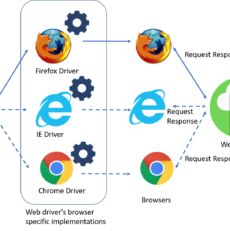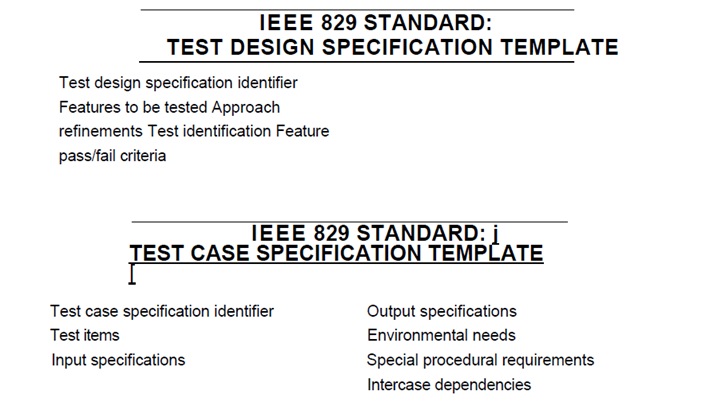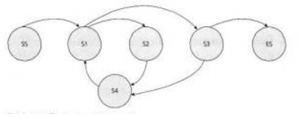
2023-02-13
KHOÁ HỌC AUTOMATION TEST CHO WEBSITE- sử dụng Selenium WebDriver với Java Basic To Advanced
0986775464

Question 1 What is a key characteristic of specification-based testing techniques?
Question 2 An exhaustive test suite would include:
Question 3 Which statement about testing is true?
Question 4 For a test procedure that is checking modifications of customers on a database, which two steps below would be the lowest priority if we didn’t have time to execute all of the steps?
1 Open database and confirm existing customer
2 Change customer’s marital status from single to married
3 Change customer’s street name from Parks Road to Park Road
4 Change customer’s credit limit from 500 to 750
5 Replace customer’s first name with exactly the same first name
6 Close the customer record and close the database
Question 5 Consider the following list of either product or project risks:
I An incorrect calculation of fees might shortchange the organization.
II A vendor might fail to deliver a system component on time.
IIIA defect might allow hackers to gain administrative privileges.
IVA skills gap might occur in a new technology used in the system.
V A defect-prioritization process might overload the development team.
Which of the following statements is true?
Question 6 Consider the following statements about regression tests:
I They may usefully be automated if they are well designed.
II They are the same as confirmation tests (re-tests).
III They are a way to reduce the risk of a change having an adverse affect elsewhere in the system.
IV They are only effective if automated.
Which pair of statements is true?
Question 7 Which of the following could be used to assess the coverage achieved for structure-based (white-box) test techniques?
V Decision outcomes exercised
W Partitions exercised
X Boundaries exercised
Y Conditions or multiple conditions exercised
Z Statements exercised
Question 8 Review the following portion of an incident report.
1 I place any item in the shopping cart.
2 I place any other (different) item in the shopping cart.
3 I remove the first item from the shopping cart, but leave the second item in the cart.
4 I click the < Checkout > button.
5 I expect the system to display the first checkout screen. Instead, it gives the pop-up error message, ‘No items in shopping cart. Click <Okay> to continue shopping.’
6 I click < Okay >.
7 I expect the system to return to the main window
to allow me to continue adding and removing items from the cart. Instead, the browser terminates.
8 The failure described in steps 5 and 7 occurred in each of three attempts to perform steps 1,2,3,4 and 6.
Assume that no other narrative information is included in the report. Which of the following important aspects of a good incident report is missing from this incident report?
Question 9 Which of the following are benefits and which are risks of using tools to support testing?
1 Over-reliance on the tool
2 Greater consistency and repeatability
3 Objective assessment
4 Unrealistic expectations
5 Underestimating the effort required to maintain the test assets generated by the tool
6 Ease of access to information about tests or testing
7 Repetitive work is reduced
Question 10 Which of the following encourages objective testing?
Question 11 Of the following statements about reviews of specifications, which statement is true?
Question 12 Consider the following list of test process activities:
I Analysis and design
II Test closure activities
III Evaluating exit criteria and reporting
IV Planning and control
V Implementation and execution
Which of the following places these in their logical sequence?
Question 13 Test objectives vary between projects and so must be stated in the test plan. Which one of the following test objectives might conflict with the proper tester mindset?
Question 14 Which test activities are supported by test data preparation tools?
Question 15 If you are flying with an economy ticket, there is a possibility that you may get upgraded to business class, especially if you hold a gold card in the airline’s frequent flyer program. If you don’t hold a gold card, there is a possibility that you will get ‘bumped’ off the flight if it is full and you check in late. This is shown in Figure 7.1. Note that each box (i.e. statement) has been numbered. Three tests have already been run:

Test 1: Gold card holder who gets upgraded to business class
Test 2: Non-gold card holder who stays in economy
Test 3: A person who is bumped from the flight What additional tests would be needed to achieve 100% decision coverage?
Question 16 Consider the following types of tools:
V Test management tools
W Static analysis tools
X Modeling tools
Y Dynamic analysis tools
Z Performance testing tools
Which of the following of these tools is most likely to be used by developers?
Question 17 What is a test condition?
Question 18 Which of the following is the most important difference between the metrics-based approach and the expert-based approach to test estimation?
Question 19 If the temperature falls below 18 degrees, the heating is switched on. When the temperature reaches 21 degrees, the heating is switched off. What is the minimum set of test input values to cover all valid equivalence partitions?
Question 20 Which of these statements about functional testing is true?
Question 21 What is the purpose of confirmation testing?
Question 22 Which success factors are required for good tool support within an organization?
Question 23 Which of the following best describes integration testing?
Question 24 According to the ISTQB Glossary, debugging:
Question 25 Which of the following could be a root cause of a defect in financial software in which an incorrect interest rate is calculated?
Question 26 Assume postal rates for ‘light letters’ are: $0.25 up to 10 grams; $0.35 up to 50 grams; $0.45 up to 75 grams; $0.55 up to 100 grams.
Which test inputs (in grams) would be selected using boundary value analysis?
Question 27 Consider the following decision table. Given this decision table, what is the expected result for the following test cases?

TCI: A 26-year-old on business but with violations or accidents on his driving record
TC2: A 62-year-old tourist with a clean driving record
Question 28 What is exploratory testing?
Question 29 What does it mean if a set of tests has achieved 90% statement coverage?
Question 30 A test plan is written specifically to describe a level of testing where the primary goal is establishing confidence in the system. Which of the following is a likely name for this document?
Question 31 Requirement 24.3. A ‘Postage Assistant’ will calculate the amount of postage due for letters and small packages up to 1 kilogram in weight. The inputs are: the type of item (letter, book or other package) and the weight in grams. Which of the following conform to the required contents of a test case?
Question 32 What is the best description of static analysis?
Question 33 System test execution on a project is planned for eight weeks. After a week of testing, a tester suggests that the test objective stated in the test plan of ‘finding as many defects as possible during system test’ might be more closely met by redirecting the test effort according to which test principle?
Question 34 Consider the following activities that might relate to configuration management:
I Identify and document the characteristics of a test item
II Control changes to the characteristics of a test item
III Check a test item for defects introduced by a change
IV Record and report the status of changes to test items
V Confirm that changes to a test item fixed a defect
Which of the following statements is true?
Question 35 Consider the following state transition diagram.

Given this diagram, which test case below covers every valid transition?
Question 36 A test plan included the following clauses among the exit criteria:
During test execution, the test team detects 430 must-fix defects prior to release and all must-fix defects are resolved. After release, the customers find 212 new defects, none of which were detected during testing. This means that only 67% of the important defects were found prior to release, a percentage which is well below average in your industry. You are asked to find the root cause for the high number of field failures. Consider the following list of explanations:
I Not all the tests planned for the significant product risks were executed.
II The organization has unrealistic expectations of the percentage of defects that testing can find.
III A version-control issue has resulted in the release of a version of the software that was used during early testing.
IV The product risk analysis failed to identify all the important risks from a customer point of view.
V The product risk analysis was not updated during the project as new information became available.
Which of the following statements indicate which explanations are possible root causes?
Question 37 What is the most important factor for successful performance of reviews?
Question 38 Consider the following statements about maintenance testing:
I It requires both re-test and regression test and may require additional new tests.
II It is testing to show how easy it will be to maintain the system.
III It is difficult to scope and therefore needs careful risk and impact analysis.
IV It need not be done for emergency bug fixes.
Which of the statements are true?
Question 39 Which two specification-based testing techniques are most closely related to each other?
Question 40 Which of the following is an advantage of independent testing?
Ngoài ra bạn có thể download nhiều tài liệu hay khác về testing theo link sau: http://bit.ly/2r3szBD
Leave a comment